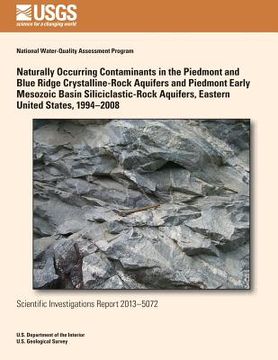Naturally Occurring Contaminants in the Piedmont and Blue Ridge Crystalline-Rock Aquifers and Piedmont Early Mesozoic Basin Siliciclastic-Rock Aquifer (en Inglés)
Reseña del libro "Naturally Occurring Contaminants in the Piedmont and Blue Ridge Crystalline-Rock Aquifers and Piedmont Early Mesozoic Basin Siliciclastic-Rock Aquifer (en Inglés)"
Groundwater quality and aquifer lithologies in the Piedmont and Blue Ridge Physiographic Provinces in the eastern United States vary widely as a result of complex geologic history. Bedrock composition (mineralogy) and geochemical conditions in the aquifer directly affect the occurrence (presence in rock and groundwater) and distribution (concentration and mobility) of potential naturally occurring contaminants, such as arsenic and radionuclides, in drinking water. To evaluate potential relations between aquifer lithology and the spatial distribution of naturally occurring contaminants, the crystalline-rock aquifers of the Piedmont and Blue Ridge Physiographic Provinces and the siliciclastic-rock aquifers of the Early Mesozoic basin of the Piedmont Physiographic Province were divided into 14 lithologic groups, each having from 1 to 16 lithochemical subgroups, based on primary rock type, mineralogy, and weathering potential. Groundwater-quality data collected by the U.S. Geological Survey (USGS) National Water-Quality Assessment (NAWQA) Program from 1994 through 2008 from 346 wells and springs in various hydrogeologic and land-use settings from Georgia through New Jersey were compiled and analyzed for this study. Analyses for most constituents were for filtered samples, and, thus, the compiled data consist largely of dissolved concentrations. Concentrations were compared to criteria for protection of human health, such as U.S. Environmental Protection Agency (USEPA) drinking water maximum contaminant levels and secondary maximum contaminant levels or health-based screening levels developed by the USGS NAWQA Program in cooperation with the USEPA, the New Jersey Department of Environmental Protection, and Oregon Health & Science University. Correlations among constituent concentrations, pH, and oxidation-reduction (redox) conditions were used to infer geochemical controls on constituent mobility within the aquifers. Of the 23 trace-element constituents evaluated, arsenic, manganese, and zinc were detected in one or more water samples at concentrations greater than established human health-based criteria. Arsenic concentrations typically were less than 1 microgram per liter ( g/L) in most groundwater samples; however, concentrations of arsenic greater than 1 g/L frequently were detected in groundwater from clastic lacustrine sedimentary rocks of the Early Mesozoic basin aquifers and from metamorphosed clastic sedimentary rocks of the Piedmont and Blue Ridge crystalline rock aquifers. Groundwater from these rock units had elevated pH compared to other rock units evaluated in this study. Of the nine samples for which arsenic concentration was greater than 10 g/L, six were classified as oxic and three as anoxic, and seven had pH of 7.2 or greater. Manganese concentrations typically were less than 10 g/L in most samples; however, 8.3 percent of samples from the Piedmont and Blue Ridge crystalline-rock aquifers and 3.0 percent of samples from the Early Mesozoic basin siliciclastic rock aquifers had manganese concentrations greater than the 300- g/L health-based screening level. The positive correlation of manganese with iron and ammonia and the negative correlation of manganese with dissolved oxygen and nitrate are consistent with the reductive dissolution of manganese oxides in the aquifer. Zinc concentrations typically were less than 10 g/L in the groundwater samples considered in the study, but 0.4 percent and 5.5 percent of the samples had concentrations greater than the health-based screening level of 2,000 g/L and one-tenth of the health-based screening level, respectively. The mean rank concentration of zinc in groundwater from the quartz-rich sedimentary rock lithologic group was greater than that for other lithologic groups even after eliminating samples collected from wells constructed with galvanized casing.

